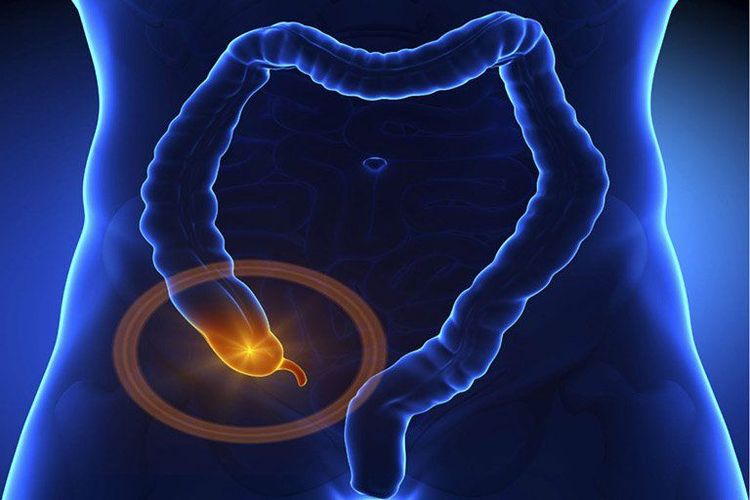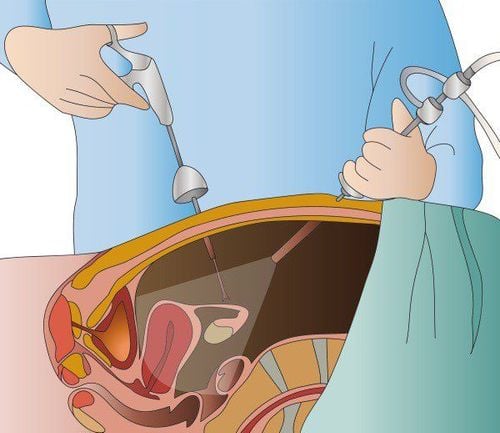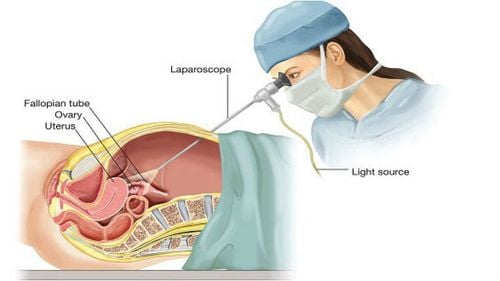This is an automatically translated article.
The article was written by MSc Vu Van Quan - Gastroenterologist - Department of General Surgery & Anesthesiology - Vinmec Hai Phong International General HospitalLaparoscopic appendectomy was first performed by Kurt Semm in 1983. With the advantages of minimally invasive surgery, this method has been widely applied and gained popularity. Since then, it is considered the gold standard in the treatment of acute appendicitis and other diseases such as appendiceal mucinous tumor, appendiceal cancer.
1. Indications for appendectomy
Acute appendicitis Chronic appendicitis Appendiceal cancer Appendiceal mucinous tumor Cases of peritonitis due to ruptured appendix

Chỉ định phẫu thuật cắt ruột thừa khi bị viêm ruột thừa cấp hay mãn tính
2. Prepare the patient
Cleaning the surgical area Basic tests, chest X-ray Electrocardiogram for patients 40 years of age and older Explain to the patient and family about: disease status, general condition, surgical methods , complications, possible complications due to pathology, surgery, anesthesia and the patient's location. Answer questions from patient and family about pathology and surgery to the extent allowed Fasting before surgery (ideally > 6 hours) Allow patient to urinate before surgery
3. Perform surgery
The patient is under general anesthesia The surgeon will open small holes in the abdomen, usually 03 holes, the position of the holes depends on the surgeon. From those small holes, the surgeon will inflate CO2 for the abdomen to inflate and then insert the instrument to conduct an examination to assess the condition of the peritoneum, exposed organs and assess the condition of the appendix; cut the appendix and remove it from the abdominal wall; then those openings will be closed

Phẫu thuật viên tiến hành phẫu thuật nội soi ổ bụng để cắt ruột thừa
4. Accidents and complications
Peritoneal bleeding: can originate from the mesenteric artery, damage to the mesenteric ileocecal vessels, the right external iliac bundle; or bleeding from the abdominal wall at the site of trocar placement. In this case, if medical treatment fails, surgery is indicated to stop the bleeding. Generalized peritonitis : due to rupture of the appendix, damage to the cecum, small intestine. Need surgery again to repair the injury. Injury to the right ureter: The ureter is torn, the tear is sutured and the surgical site is drained. If the ureter is completely ruptured, it can be immediately connected to the end with drainage. If immediate anastomosis is not available, the upper end of the ureter must be brought out to the abdominal wall. After a while, the ureter will be reconnected. Residual Abscess: Treated as intraperitoneal abscesses.

Người bệnh cần được theo dõi để tránh bị tai biến và biến chứng sau phẫu thuật
5. Post-surgery care
After fully awake, the patient will be instructed on how to eat again, how to exercise at bed and gradually return to activity. Because the invasive impact on the abdomen is minimal, patients after surgery will have very little pain, can eat and return to activities very soon. Feed after 6-8 hours. Get up, walk around after 6-8 hours. Discharge after 24-48 hours. Currently, Vinmec Hai Phong International General Hospital has been implementing the laparoscopic appendectomy method with the strengths of:
Experienced and proficient doctors in each step of the operation Anesthesiology qualifications , anesthesia and analgesia after surgery are very good, leading in the application of advanced methods of anesthesia - anesthesia. Modern equipment system such as modern endoscope system. Along with the dedication of the hospital staff will certainly bring satisfaction to patients. Customers can go directly to Vinmec Hai Phong to visit or contact hotline 0225 7309 888 for support.














